MYLÈNE GERVAIS

NO PRETTY PICTURES
reviewed by
LYDIA SCHRUFER
This
spring (March 2005) I had the pleasure of viewing an exhibition
of extraordinary prints by Mylène Gervais. Gervais is
based in Trois-Rivières, Québec, but has taken
part in solo and group exhibitions all over Canada and the world.
This socially engaged artist has spread her artistic message
to Belgium, France, Argentina, Brazil and Cuba. Mylène
Gervais has an impressive resumé: in addition to receiving
numerous prestigious art prizes and being the subject of many
articles and catalogues about her work, she is also a teacher
at Université du Québec à Trois-Rivières.
Mylène is the director general of La Corporation de développement
culturel de Nicolet and has worked with cultural and humanitarian
committees as far away as Cuba and Argentina. Her social conscience
is, and always was, well developed. She told me that as a child
she dreamed of working with an organization such as the Peace
Corps.

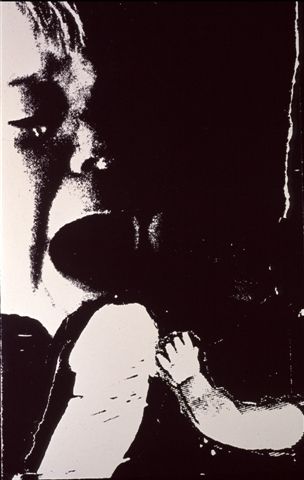 Upon
entering the exhibition, Mylène Gervais : Estampe,
the viewer encounters technically beautiful prints of velvety
black, voluptuous reds and pristine whites. I was immediately
drawn to her work even as the subject matter brought me face
to face with very disturbing images that produced a disquieting
unease. Mylène Gervais, an accomplished print maker,
examines the subject of child abuse. The fourteen, large format,
and all untitled serigraphs and wood block prints, are displayed
unframed and otherwise unadorned along the walls almost as children’s
drawings are displayed along a classroom wall. But that is where
the comparison ends, for there are no smiley faced families
under sunny skies in these pictures. Gervais, in conjunction
with a psychologist who treats victims of child abuse, has deeply
researched the phenomenon -- the experience of which has profoundly
informed her art.
Upon
entering the exhibition, Mylène Gervais : Estampe,
the viewer encounters technically beautiful prints of velvety
black, voluptuous reds and pristine whites. I was immediately
drawn to her work even as the subject matter brought me face
to face with very disturbing images that produced a disquieting
unease. Mylène Gervais, an accomplished print maker,
examines the subject of child abuse. The fourteen, large format,
and all untitled serigraphs and wood block prints, are displayed
unframed and otherwise unadorned along the walls almost as children’s
drawings are displayed along a classroom wall. But that is where
the comparison ends, for there are no smiley faced families
under sunny skies in these pictures. Gervais, in conjunction
with a psychologist who treats victims of child abuse, has deeply
researched the phenomenon -- the experience of which has profoundly
informed her art.
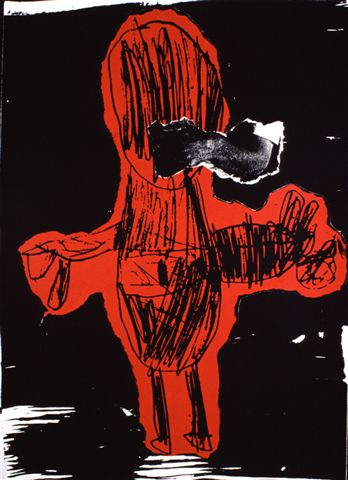
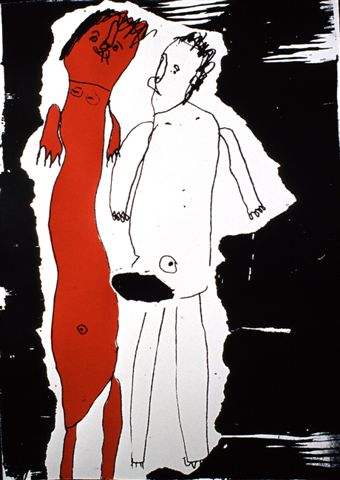 I
hadn’t met the artist before seeing her work so I was
completely surprised to see such a young woman. The prints are
so powerful and multi-faceted that I expected a much older person.
Other visitors circulating around me were also asking how such
a young person (mid thirties) could produce such profound work.
Gervais avoided the temptation to exaggerate the horror inherent
in the subject. Instead, she created stunning images that invite
the viewer to contemplate the violent injustice done to children.
Her accomplished technique allows us to contemplate the pathos
of not only the child’s pain, but the anguish surrounding
the perpetrators who inflict it. By making her work aesthetically
accessible she promotes public awareness.
I
hadn’t met the artist before seeing her work so I was
completely surprised to see such a young woman. The prints are
so powerful and multi-faceted that I expected a much older person.
Other visitors circulating around me were also asking how such
a young person (mid thirties) could produce such profound work.
Gervais avoided the temptation to exaggerate the horror inherent
in the subject. Instead, she created stunning images that invite
the viewer to contemplate the violent injustice done to children.
Her accomplished technique allows us to contemplate the pathos
of not only the child’s pain, but the anguish surrounding
the perpetrators who inflict it. By making her work aesthetically
accessible she promotes public awareness.
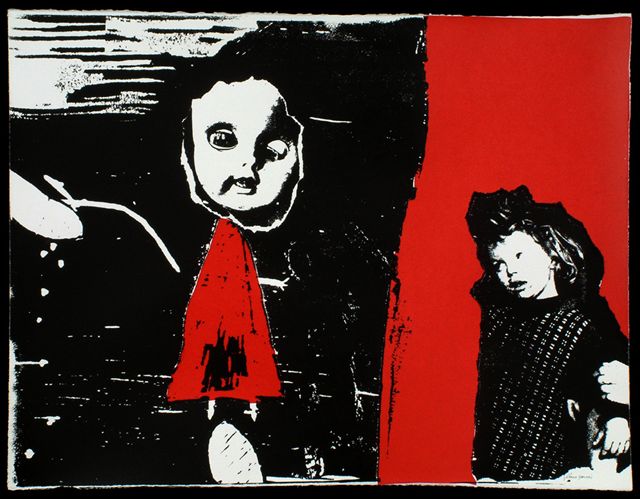
Artist
as social commentator is not a new phenomenon. From Francisco
Goya (1746-1828) and Honoré Daumier (1808-1879) to contemporary
artists like Eric Fischle, artists have been moved to depict
their reactions to injustice. The artists we remember are not
the ones who ranted loudly but those who moved us through the
power of their art. Gervais meets those criteria which is why
her images are memorable. The works are surface shallow, almost
depthless, with densely saturated colors. Black, red and white
transmit anger, evil, despair and other equally disturbing emotions.
Mylène deliberately restricts her pallet to those three
colors, explaining that they, in particular, elicit strong psychological
associations in most people.

I
asked Mylène how her own children, Myrtille and Victor,
who were in attendance at the vernissage, had reacted to the
pictures. She confessed that she had been anxious about how
they would react since they hadn’t seen the work before,
(she had only spoken to them about it), but as it turned out
her anxiety was unfounded. They had no response other than finding
the children in the pictures sad, but didn’t understand
why, and after a brief scan of the gallery happily resumed playing
with their cousins.
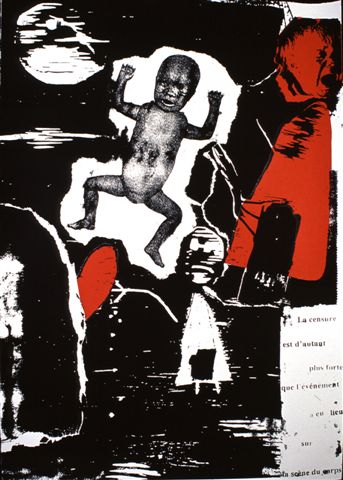 Mylène
Gervais is a hands-on artist. When I asked her if the large
prints had been printed for her she explained that she does
all her own carving, printing and inking because she loves the
process. She loves the feel of the wood and the smell of the
inks and she considers the whole creative process to be part
of the gestation period of the work. She feels that if she were
to give up part of the process, the images would lose some of
their verve.
Mylène
Gervais is a hands-on artist. When I asked her if the large
prints had been printed for her she explained that she does
all her own carving, printing and inking because she loves the
process. She loves the feel of the wood and the smell of the
inks and she considers the whole creative process to be part
of the gestation period of the work. She feels that if she were
to give up part of the process, the images would lose some of
their verve.
Mylène
Gervais has a Bachelor of Studio Art, a Masters Degree in the
Visual Arts and has spent many years perfecting her technique
in Serbia, Brazil, Buenos Aires, Cuba, Belgium and Holland.
It is no surprise that she’s totally at home in the printmaking
studio.
When
I asked Mylène how she came to choose such a heavy subject,
she said she has always been engaged by socially sensitive issues
such as war atrocities, incest, suicide and sexual abuse. Her
aim is to explore and expose subjects that society would rather
not face, and through her art, make us aware of and sensitive
to injustices everywhere. If the prints were only about ugliness
and horror they would defeat the purpose. By making beautiful
images about awful events, the viewer is encouraged to look
more closely and contemplate more deeply.
The
exhibition took place at the Vieux Presbytère in St-Bruno-de-Montarville
on Montreal’s South Shore. This art venue, with an ever
increasing list of very impressive exhibitions, is under the
dynamic direction of Hélène Vanier, who is not
afraid of controversy, and often invites -- with a jury -- artists
to challenge the viewer. The Vieux Presbytère is divided
into large and smaller spaces so visitors may move through it
room by room. The building once served as a typical Canadiana
residence, so it is definitely not the usual white-cube gallery.
The room divisions create a viewing intimacy not found in the
traditional cold, open concept gallery and re-enforce the fact
that much child abuse takes place in just such mundane domestic
environments.

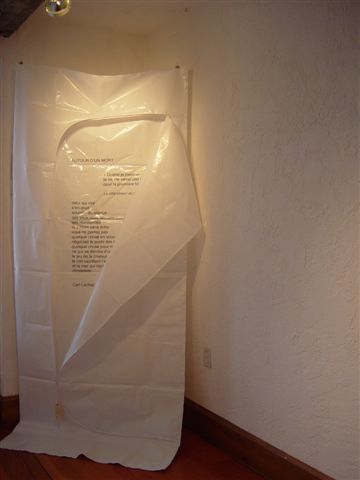 The
last room I visited held a glimpse of the next project Gervais
will be working on. It housed the first installment of the project
entitled Chrysalide. There, I saw the poetry of Carl
Lacharite digitally printed along the length of authentic, white
body bags. Although the concept is not yet completely resolved,
Gervais, in collaboration with her poet/friend Lacharite, will
explore the subject of death and its many causes: illness, suicide
etc. The plan is for every body-bag to address a particular
aspect of death. Again, it is not a comfortable subject but
I am certain Mylène Gervais will handle it with the same
intriguing expertise she has demonstrated in this exhibition.
The
last room I visited held a glimpse of the next project Gervais
will be working on. It housed the first installment of the project
entitled Chrysalide. There, I saw the poetry of Carl
Lacharite digitally printed along the length of authentic, white
body bags. Although the concept is not yet completely resolved,
Gervais, in collaboration with her poet/friend Lacharite, will
explore the subject of death and its many causes: illness, suicide
etc. The plan is for every body-bag to address a particular
aspect of death. Again, it is not a comfortable subject but
I am certain Mylène Gervais will handle it with the same
intriguing expertise she has demonstrated in this exhibition.
For
more information on the artist, please contact Arts Editor
Lydia
Schrufer.